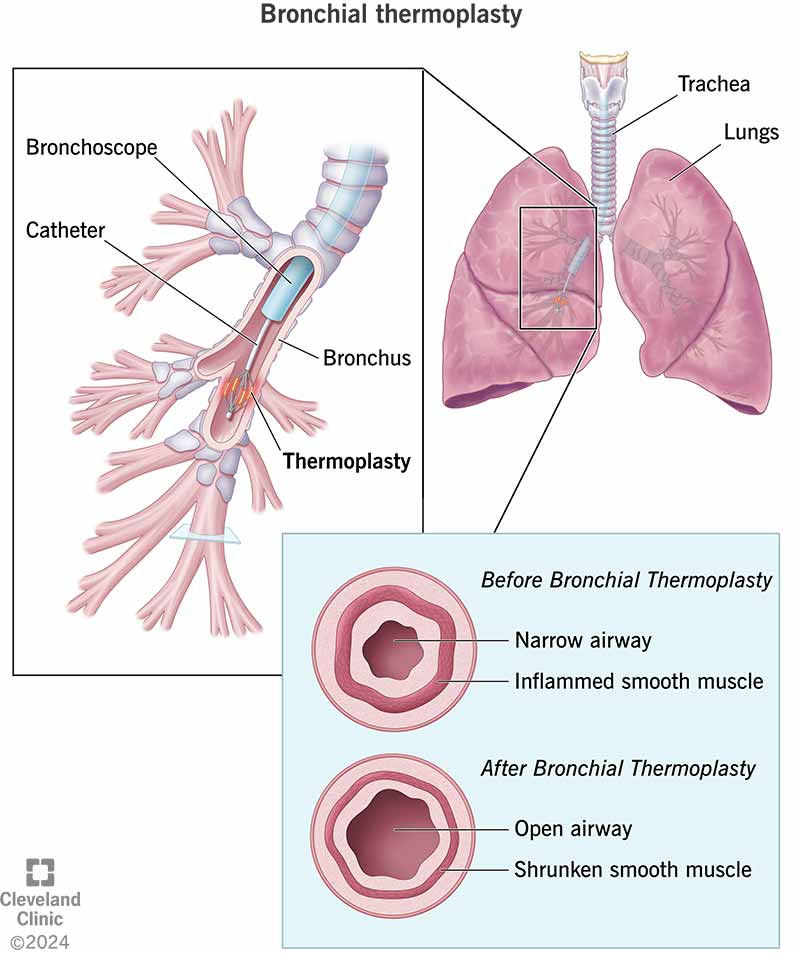Bronchial thermoplasty is a procedure healthcare providers use to treat severe asthma. A provider applies heat to the smooth muscles around your lungs to shrink them. It might reduce asthma attacks and improve quality of life in people who have asthma that doesn’t improve with standard treatments.
Advertisement
Cleveland Clinic is a non-profit academic medical center. Advertising on our site helps support our mission. We do not endorse non-Cleveland Clinic products or services. Policy

Bronchial thermoplasty is a procedure that can help treat severe asthma. A healthcare provider (usually a pulmonologist) uses a thin tube to apply heat to the muscles around your airways, thinning them. Most people need three procedures to treat all areas of their lungs.
Advertisement
Cleveland Clinic is a non-profit academic medical center. Advertising on our site helps support our mission. We do not endorse non-Cleveland Clinic products or services. Policy
If you have asthma, inflammation and contraction of the smooth muscles in your lungs make it hard to breathe, especially during an attack (exacerbation). Bronchial thermoplasty can give you more room to breathe and reduce your risk of an attack.
You might be a candidate for bronchial thermoplasty if you have severe asthma that isn’t manageable with standard treatments, like inhalers, oral medications or biologics. Severe asthma can mean you have:
To prepare for the procedure, your provider may ask you to:
During bronchial thermoplasty, a healthcare provider will:
Advertisement
Each thermoplasty procedure takes about 45 minutes to an hour.
After the procedure, healthcare providers will monitor you for at least a few hours as you wake up and recover. If you have worsening symptoms or side effects, you may need to spend the night in the hospital.
You’ll need three thermoplasty treatments to treat all areas of your lungs. Your provider will treat a different area of your lung in each procedure — your right and left lower lobes are treated in two different sessions, and both of your upper lobes are treated together in a third session. (Your right middle lobe isn’t treated to avoid the risk of collapse.) The sessions take place at least three weeks apart.
Bronchial thermoplasty can reduce the severity or frequency of your asthma symptoms. You might be less likely to have asthma attacks after the procedure.
But bronchial thermoplasty doesn’t cure asthma. You’ll still need medication to help manage your symptoms.
Risks of bronchial thermoplasty include:
Some people have new symptoms or symptoms that get worse in the days following the treatment, including:
These symptoms usually get better within a week of the procedure. Ask your provider what to expect and when to contact them or go to the emergency room.
Some people start to see symptom improvement soon after their first treatment. Others might not see improvement until recovering from all three treatments, or only see minor improvements.
In one study, bronchial thermoplasty reduced airway smooth muscle mass by 53% in people who had the procedure. Other studies suggest bronchial thermoplasty could improve the quality of life for people with severe asthma and reduce the number of exacerbations.
Studies suggest that the positive effects of bronchial thermoplasty — like improved quality of life and reduced exacerbations — last at least 10 years. As the treatment is still relatively new, there haven’t been studies to see if the effects last longer than that yet.
Contact your healthcare provider about any concerns you have before or after the procedure.
Go to the emergency room if you experience:
Asthma can have a big impact on your ability to enjoy life, especially if you’re having attacks frequently. You might wonder if there is anything else that could help you feel better.
Bronchial thermoplasty isn’t an option for everyone. If you’re consistently using your prescription medications and feel like asthma is severely impacting your quality of life, you and your provider can discuss whether other options could be a good fit.
Advertisement
You might feel anxious when your child gasps and wheezes. Cleveland Clinic Children’s asthma experts are here to help them (and you) breathe easier.

Last reviewed on 10/07/2024.
Learn more about the Health Library and our editorial process.